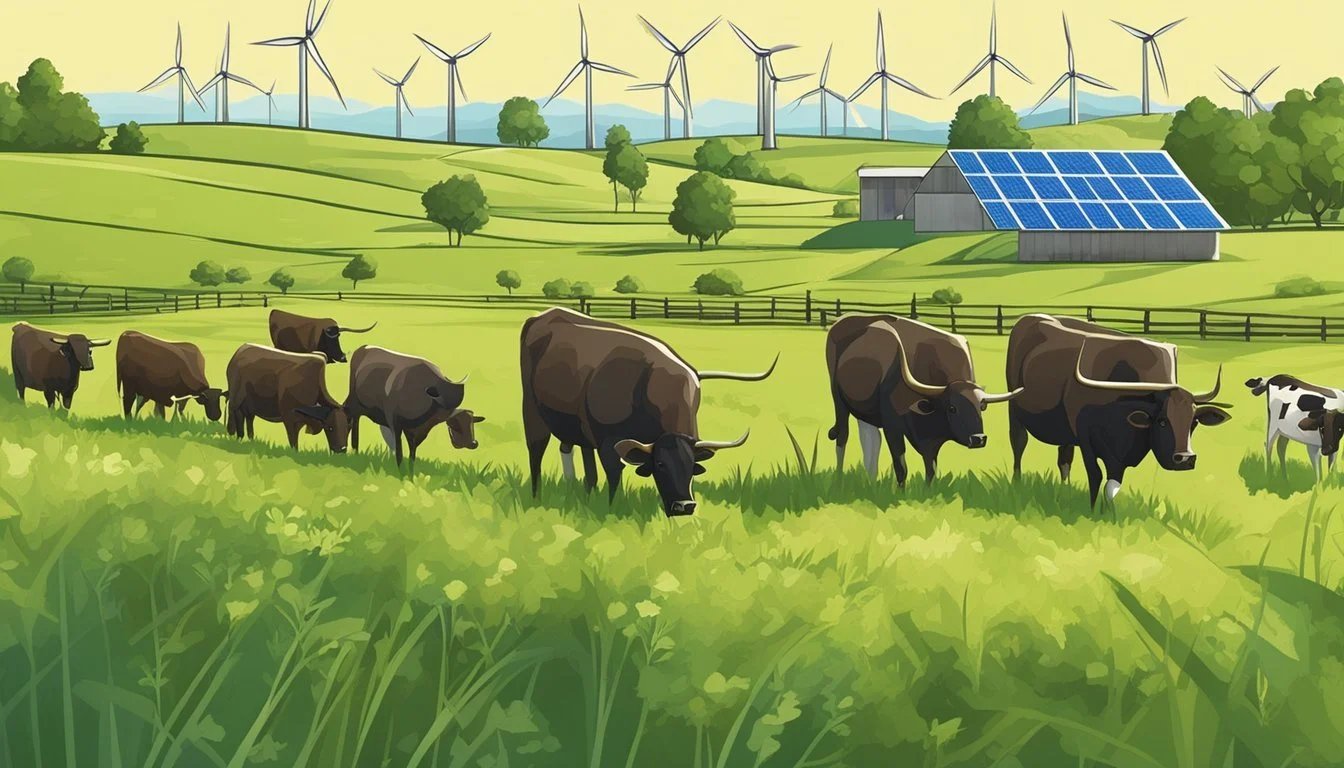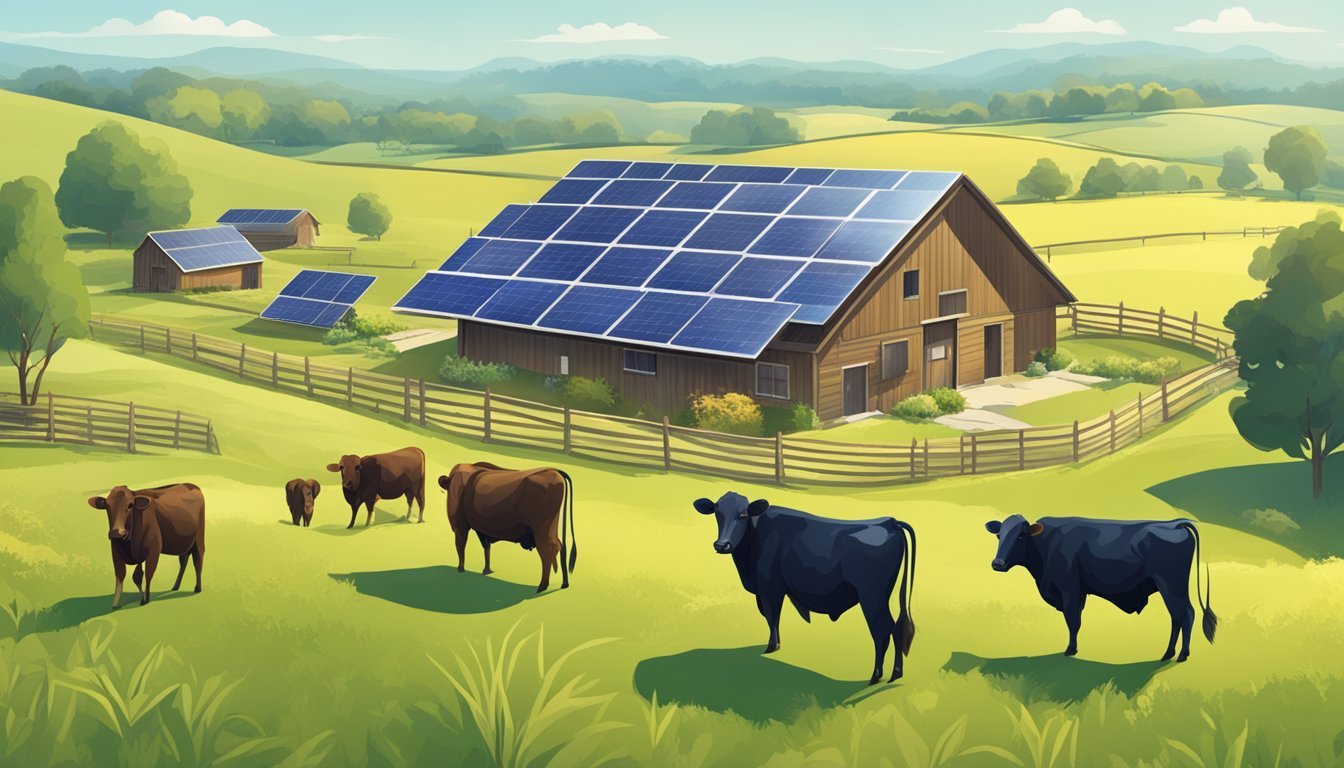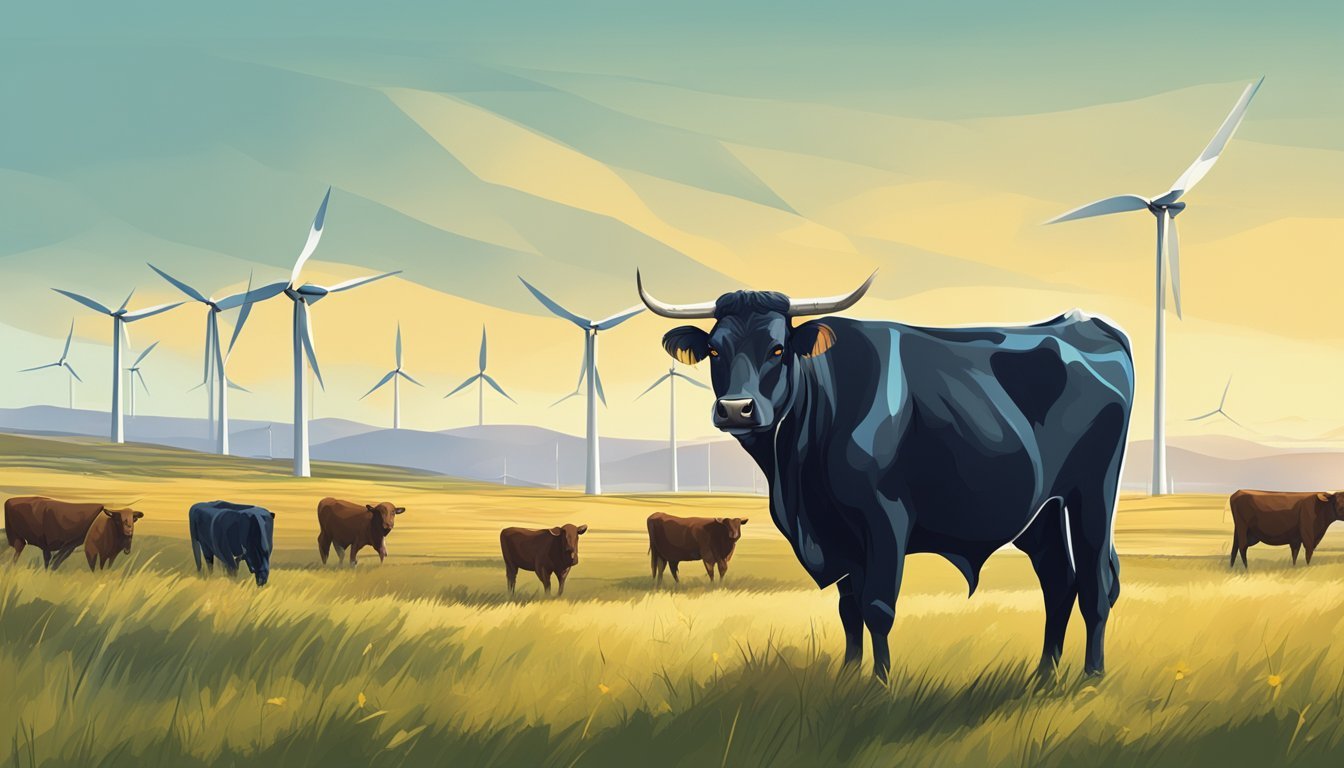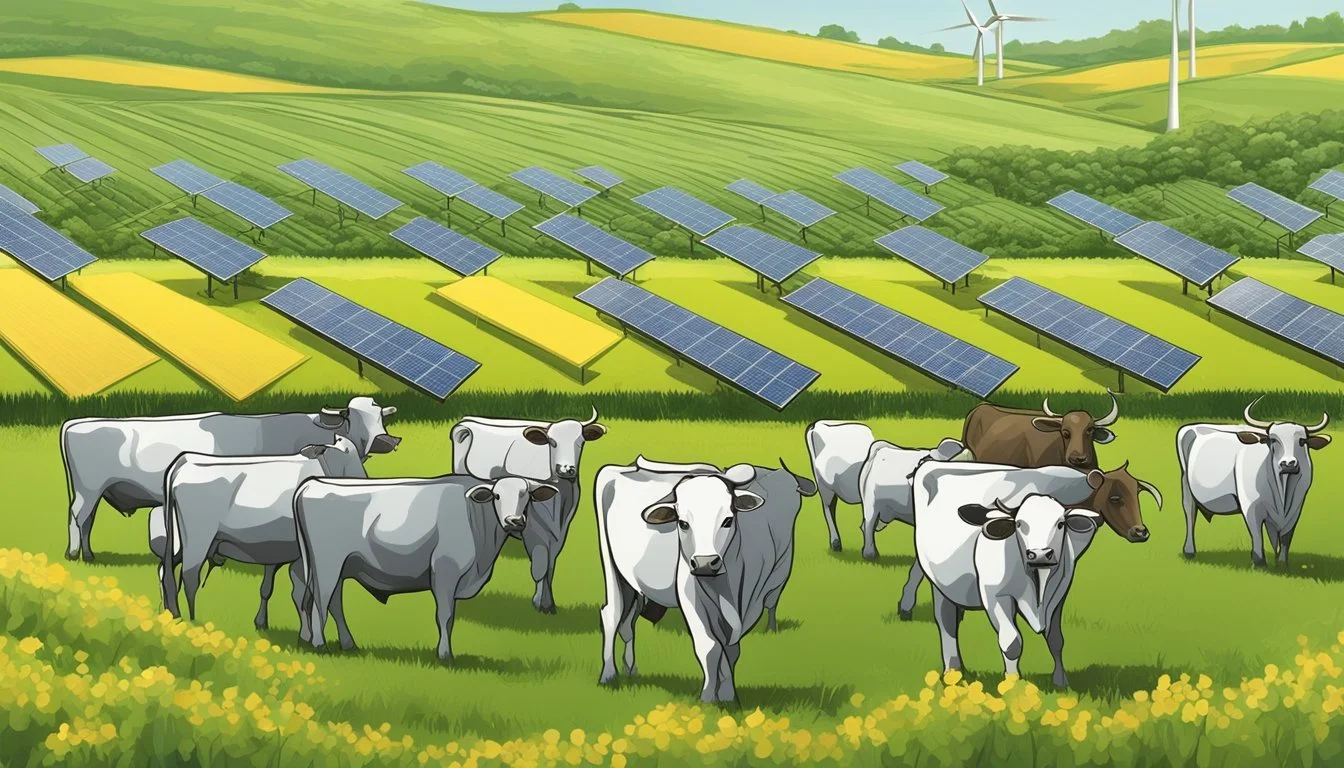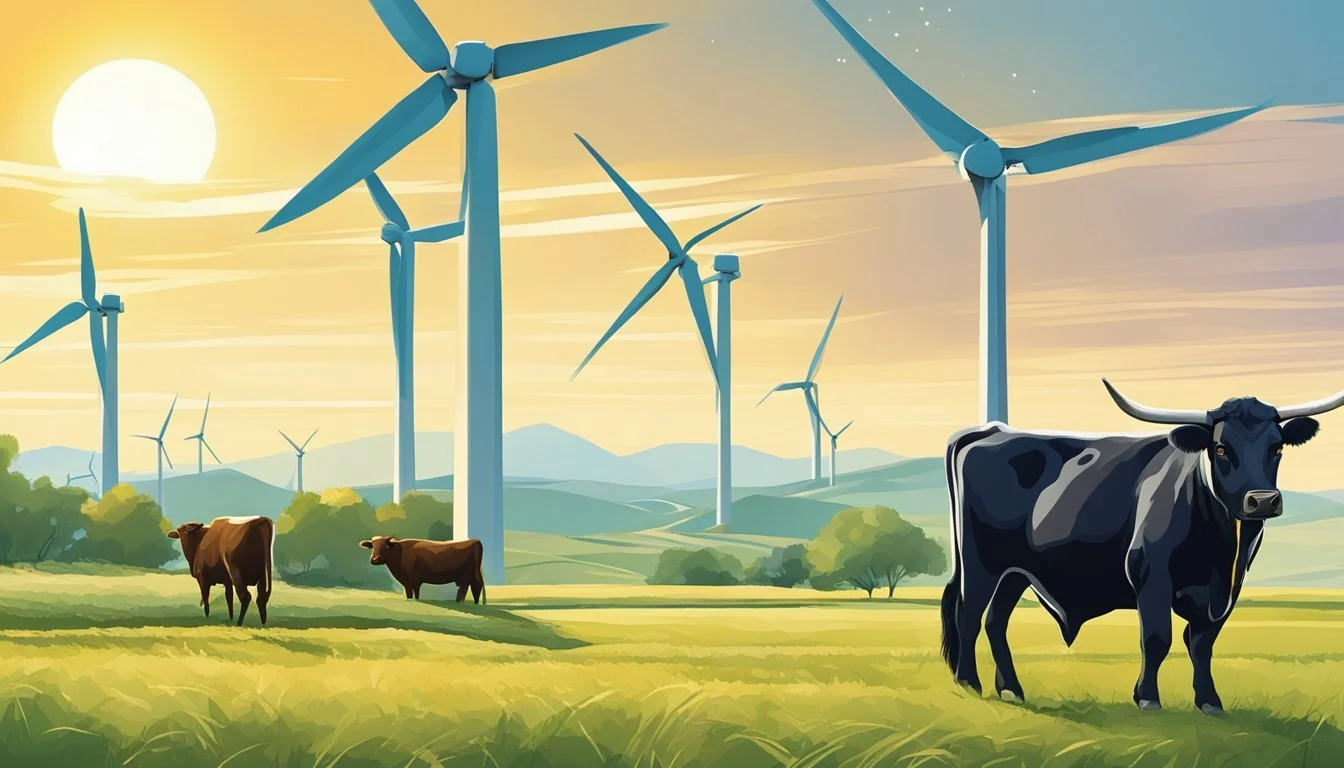Dexter Cattle and Renewable Energy
Innovative Strategies for Eco-Friendly Farming
Dexter cattle, a hardy and versatile breed, are creating a sustainable revolution on modern farms. These small-sized cows not only efficiently provide meat and milk, but also fit seamlessly into the growing trend of integrating renewable energy practices on farms. Farmers are continuously looking for innovative methods to reduce their carbon footprint and increase self-sufficiency, and Dexter cattle, with their lower feed requirements and adaptable nature, complement these goals perfectly.
Renewable energy emerges as a cornerstone of this sustainable transformation. By harnessing solar, wind, and bioenergy, farms can significantly cut down on external energy requirements, slashing bills and contributing to a healthier planet. Dexter cattle operations, often smaller than standard dairy or beef farms, are particularly well-suited to capitalize on these renewable technologies due to their reduced scale and impact on the land.
As farmers expand their use of renewable energy sources such as bio-digesters, which convert organic waste into power and heat, the synergy between Dexter cattle and sustainability becomes even more evident. These compact ruminants can play a pivotal role in a farm's energy cycle by providing valuable manure for bioenergy production, thereby closing the loop on a truly sustainable farming ecosystem.
The Rise of Dexter Cattle in Sustainable Farming
Integrating Dexter cattle into sustainable agricultural practices is gaining traction among small farms focused on efficiency, conservation, and renewable energy utilization.
Dexter Cattle: An Overview
Dexter cattle are Europe's smallest cattle breed, known for their hardiness and adaptability. Standing at 36 to 44 inches at the shoulder, they belong to a breed that excels in a variety of climates and conditions. Their smaller stature means they require less space and resources than larger breeds, positioning them as a practical choice for sustainable livestock farming.
Benefits for Small Farms
Dexter cattle offer numerous advantages for small-scale farms:
Resource Efficiency: With their modest size, Dexter cattle consume considerably less feed compared to larger breeds, translating into lower food costs and decreased strain on resources.
Premium Beef Quality: Exhibiting exceptional beef quality, Dexter cattle have been recognized for their meat's taste profile, ranking highly in taste competitions and following closely behind the renowned Japanese Wagyu beef.
Grazing and Land Management
Dexter cattle are instrumental in land management strategies conducive to sustainable agriculture. Their grazing habits prevent overgrowth and contribute to maintaining a healthy ecosystem, which proves essential for farmland regeneration. Additionally, their role in conservation and rewilding projects underscores their value in enhancing biodiversity and encouraging robust ecosystems on agricultural lands. Small farms utilizing Dexter cattle for grazing can witness improved land health and a reduction in the need for artificial fertilizers, aligning closely with sustainable principles and renewable energy practices.
Understanding Renewable Energy in Agriculture
In agriculture, the integration of renewable energy solutions is transforming farms into self-sufficient entities capable of producing clean energy. This shift not only contributes to energy cost savings but also to the ecological betterment by lowering greenhouse gas emissions.
Types of Renewable Energy Sources
Agricultural operations can benefit from an array of renewable energy sources, each with its own applicability and benefits. Key renewable sources include:
Solar Power: Utilizing photovoltaic cells, farms can convert sunlight into electricity. This energy is used to power various agricultural operations.
Wind Energy: Through wind turbines, kinetic energy from wind is transformed into electrical power.
Biogas: The process of anaerobic digestion of organic farm waste produces biogas, a renewable natural gas, which can be utilized for heating or electricity.
Hydroelectric Power: In farm locations with access to flowing water, hydroelectric systems can generate electricity.
Biomass: This involves the production of energy from plant materials and animal waste used for electricity and heating.
Advantages of Renewable Energy for Farms
The adoption of renewable energy in agriculture brings numerous advantages:
Cost-Effectiveness: After initial setup, farms can reduce ongoing energy costs since the sources—such as sunlight and wind—are free.
Energy Independence: Farms can potentially become energy-independent, reducing reliance on external energy supplies.
Sustainability: Using renewable energy significantly lowers the farm's carbon footprint, supporting a more sustainable agricultural practice.
Additional Revenue Streams: Farms might generate excess energy that can be sold back to the grid, creating an additional income source.
Reliability and Efficiency: Renewable energy systems can contribute to a reliable and efficient energy supply for long-term farm operations.
Renewable energy has the potential to reshape the agricultural landscape, offering a viable pathway to energy sustainability and economic resilience for farms.
Solar Energy Systems on Farms
Solar energy systems on farms offer a dual benefit: they power farm operations while potentially enhancing land use efficiency.
Solar Power Operations
Solar power operations on farms typically involve the installation of photovoltaic (PV) systems. These systems convert sunlight directly into electricity using solar panels. For a successful implementation, farmers assess factors such as the farm’s electrical load, the optimal size of the PV system, and local solar insolation levels. Solar power can serve various farm needs, from running machinery to powering lights. Configurations vary based on scale: small systems may be less than 5kW, while large installations can exceed this figure.
Integration with Agriculture Practices
Integrating solar energy with agriculture practices can reduce a farm's carbon footprint and stabilize energy costs. Agrivoltaics is a practice where solar panels are installed alongside crops, maximizing land use. This configuration can provide shade for certain crops, reduce water loss through evaporation, and allow for light to permeate to the plants below, depending on the spacing and orientation of panels.
Solar Energy for Crop and Animal Production
Solar energy plays a crucial role in both crop and animal production. For crops, solar thermal systems can heat water for irrigation or processing needs. Animals benefit from solar energy as it can power ventilation systems, milking machines, and other equipment. It ensures a continuous power supply, which is especially vital for temperature-sensitive livestock like Dexter cattle. Co-locating solar arrays with pasture can shield animals from extreme weather, further leveraging the utility of solar installations on farms.
Wind Energy Utilization
Wind energy is becoming an increasingly important resource for sustainable agriculture. Farms can harness this clean power source through the installation of wind turbines, which can significantly reduce reliance on external energy supplies.
Farm-Scale Wind Turbines
Farm-scale wind turbines provide a practical solution for farmers to generate their own electricity. These turbines are designed to fit the specific needs of a farming operation, with sizes and capacities that vary depending on the energy demand. They are typically smaller than commercial-scale turbines and can be integrated into the farm without requiring extensive land use. The technology involved in these wind-powered systems is advancing, making it more efficient and affordable for the farmer.
Key considerations when implementing farm-scale wind turbines include:
Site assessment: Evaluating wind resources and potential turbine locations.
Energy needs: Matching turbine size to the farm's energy consumption patterns.
Zoning and permits: Complying with local regulations concerning the installation of wind turbines.
The Role of Wind Power in Farming
Wind power provides farmers with an avenue for self-sufficiency and additional income streams. By generating their own electricity, they can reduce utility costs and even gain revenue from feeding excess power back into the grid.
Wind contributes to sustainable agricultural practices by:
Reducing carbon footprint: Wind energy replaces fossil fuels, cutting greenhouse gas emissions.
Energy independence: On-site generation reduces dependency on external energy sources.
Economic benefits: Participation in renewable energy programs can offer financial incentives to farmers.
For farming communities, wind power represents a reliable and renewable energy option that aligns with environmental stewardship and economic resilience. Farm-scale turbines are a key component in the evolving landscape of rural energy infrastructure.
Biogas Production from Livestock Manure
Biogas production is an efficient way to manage livestock manure while generating renewable energy. This process not only reduces methane emissions but can lead to energy independence for farms.
Anaerobic Digestion Basics
Anaerobic digestion is a process by which microorganisms break down organic materials in the absence of oxygen. In the context of livestock manure management, it involves the decomposition of manure to produce biogas, a mixture consisting primarily of methane and carbon dioxide.
Process: Livestock manure is collected and fed into an anaerobic digester.
Conditions: The digester maintains optimal conditions for microbes, including temperature, pH, and absence of oxygen.
Outcome: The output is biogas rich in methane and digestate, which can be used as fertilizer.
Methane Capture and Utilization on Farms
Farms that implement anaerobic digesters can capture methane, a potent greenhouse gas, and use it to generate electricity or heat.
Energy Production: Methane from biogas can be combusted to generate electricity or used in a combined heat and power (CHP) system.
Benefits:
Reduces reliance on fossil fuels
Lowers methane emissions
Contributes to energy independence
Provides a consistent energy supply
Storage: Any excess biogas can be stored for later use, or in some cases, cleaned and injected into natural gas pipelines.
Through these methods, farms utilizing anaerobic digestion can turn waste into a valuable resource, effectively managing manure and reducing their environmental impact.
Synergies between Livestock and Energy Crops
Integrating Dexter cattle and energy crops on the farm can maximize land use efficiency and provide multiple streams of revenue.
Co-benefits of Raising Dexter Cattle and Energy Crops
Dexter cattle, a hardy and versatile breed, have shown compatibility with energy crop cultivation, notably in systems where switchgrass is grown. Switchgrass not only serves as a biofuel resource but can also act as forage for Dexter cattle, creating a dual land-use scenario. This synergy enhances the sustainability of farms by allowing them to produce both livestock and biomass for energy on the same acreage.
Advantages of Dexter cattle include their smaller size, making them well-suited for grazing among crop rows. They can effectively utilize the undergrowth without damaging the taller energy crops designated for harvest. Additionally, the Dexter's ability to thrive on less intensive care reduces labor and input costs.
The cultivation of switchgrass itself requires minimal input once established. It can grow on marginal lands with lower fertility, areas that may not be suitable for other crops. This allows for the strategic usage of land resources, where prime lands can be allocated for high-value food crops, and less fertile areas can support energy crop production.
Lastly, switchgrass as an energy crop can serve to reduce greenhouse gas emissions when used as a biofuel, contributing positively to the farm's overall carbon footprint. The ability to both provide for the cattle and produce an energy source from the same crop exemplifies the balance between agricultural productivity and environmental stewardship.
Economic Aspects of Sustainable Farming
Sustainable farming practices, such as the integration of Dexter cattle and renewable energy, often lead to significant economic benefits. Farmers can experience cost reductions and develop diverse revenue streams, bolstered by government incentives and support.
Cost Savings and Revenue Streams
Farmers who integrate renewable energy into their operations typically find that these systems significantly reduce operating costs over time. For instance, solar or wind power installations can lower electricity bills, which comprise a substantial portion of a farm's fixed expenses. Dexter cattle, being a hardy and low-maintenance breed, contribute to the profitability model by requiring less feed and care than larger breeds, thereby reducing expenses related to livestock management.
Key Cost Savings:
Reduced energy bills through solar, wind, or biofuel systems
Lower livestock maintenance costs due to the hardiness of Dexter cattle
Additionally, renewable energy installations can generate a new revenue stream. Surplus electricity can be sold back to the grid, turning an operational cost into a source of income. Biofuels produced on the farm may also be sold, adding to the farm's revenue streams.
Potential Revenue Streams:
Electricity sold back to the grid
Biofuels provided to local markets
Government Incentives and Support
Governments often provide various incentives and support programs to encourage the adoption of renewable energy on farms. These may include grants, tax credits, or subsidized loans that lower the initial investment hurdle, making it financially feasible for farmers to implement sustainable technologies.
Incentives may include:
Tax Credits: Reduction in tax liability for eligible renewable energy projects
Grants: Direct funding support for purchasing renewable energy equipment
Subsidized Loans: Low-interest financing to manage upfront costs of installations
Such financial support not only aids in the farm's transition to sustainability but also boosts its long-term profitability. By leveraging these incentives, farmers can more readily invest in strategies that will reduce ongoing operating costs and enhance income generation opportunities.
Environmental Impacts and Conservation
In the context of agriculture and livestock management, mitigating environmental impacts while promoting conservation practices stands at the forefront of sustainable farming. Dexter cattle and renewable energy sources present opportunities to reduce harmful emissions and preserve essential natural resources.
Reducing Greenhouse Gas Emissions
Greenhouse Gas Emissions: Climate change is exacerbated by greenhouse gases, notably CO2 and methane, which are significant byproducts of conventional farming practices. Renewable energy systems like solar panels, wind turbines, and bio digesters on farms can sharply decrease reliance on fossil fuels, thereby reducing CO2 emissions. For instance, incorporating an anaerobic digestor can not only meet a farm's energy needs but also prevent approximately 12,000 metric tons of CO2 emissions associated with gasoline.
Conservation through Livestock: Dexter cattle contribute to sustainability with their smaller size, which equates to less feed consumption and waste production compared to larger breeds. This means a farm can maintain a sizable herd while potentially lowering methane emissions, an impactful greenhouse gas.
Conservation of Natural Resources
Resource Preservation: Farms utilizing renewable energy sources actively contribute to the conservation of natural resources. By generating their own power through renewable means, farmers lessen the withdrawal of non-renewable resources, thus aiding in the long-term viability of these reserves.
Water Quality and Soil Conservation: Dexter cattle are known for their hardiness and ability to thrive in various environmental conditions, potentially minimizing the need for resource-intensive farming practices. The breed's adaptability can lead to improved water quality and soil conservation, essential elements in the balance of natural ecosystems that aid in buffering against the impacts of climate change.
The Role of Dexter Cattle in Renewable Energy Initiatives
Dexter cattle serve as a valuable asset within sustainable farming practices, offering distinct contributions to renewable energy projects on farms. When utilized effectively, these cattle can enhance farm competitiveness through eco-friendly measures.
Case Studies: Dexter Cattle and Farm Energy Projects
Dexter cattle, a breed known for their hardiness and smaller size, have been integrated into various renewable energy initiatives to promote sustainability on farms. Their contributions are often twofold: first, by improving the efficiency of land management through grazing, and second, by providing a source of organic waste for energy production.
Land Management Efficiency
On the Inishowen Peninsula, the reintroduction of Dexter cattle has led to improved grazing of commonages. This not only helps maintain the land but also promotes an ecosystem balance which is a fundamental principle of renewable energy systems.Organic Waste to Energy Conversion
As Dexter cattle produce manure, it becomes a potential feedstock for anaerobic digesters. This process captures methane—a potent greenhouse gas—converting it into biogas, a form of renewable energy. Biogas can be used for heating, electricity, and even as a fuel for vehicles, making farms more self-sufficient and reducing reliance on fossil fuels.
Joint Institute for Strategic Energy Analysis (JISEA) can offer insight into the economic and environmental impacts of such farm-level renewable energy systems. Their analyses help illustrate the potential for Dexter cattle to bolster farm competitiveness in the energy market through sustainable and innovative farming practices.
Adopting a Long-Term Sustainable Mindset
Adopting a long-term sustainable mindset involves meticulously planning for energy independence while engaging with educational resources and the community. These steps ensure that the integration of renewable energy and sustainable practices become a core part of farming operations.
Planning for Energy Independence and Resilience
Farmers can achieve energy independence by assessing current energy usage and exploring renewable options that provide stable, long-term solutions for their farm's energy needs. Solar and wind energy systems are viable sources that can be incorporated into farming operations, especially in the context of Dexter cattle management, where ranch operations can be energy-intensive.
Energy Assessment: Begin with a comprehensive energy audit to understand the farm's current usage and inefficiencies.
Renewable Systems: Analyze the feasibility of installing solar panels or wind turbines to provide sustainable energy for daily operations.
US Department of Energy & USDA Support: Utilize resources from both the U.S. Department of Energy and the U.S. Department of Agriculture which offer programs for renewable energy projects to aid in the transition to sustainable energy sources.
Resilience Planning: Establish measures to protect these renewable systems from weather-related disruptions, ensuring continuous operation and longevity.
Educational Resources and Community Engagement
Educational resources are invaluable for farmers aiming to optimize their renewable energy systems and for fostering sustainability within the community.
Workshops and Training: Engage with U.S. Department of Energy and USDA-sponsored events to stay informed about the latest sustainable technologies and practices.
Knowledge Sharing: Encourage local community participation through knowledge exchange initiatives, showcasing the benefits and practicality of renewable energy systems in agriculture.
Community Projects: Collaborate with local farms and agricultural societies to pilot community-based renewable energy projects, boosting resilience and sustainability across the community.

